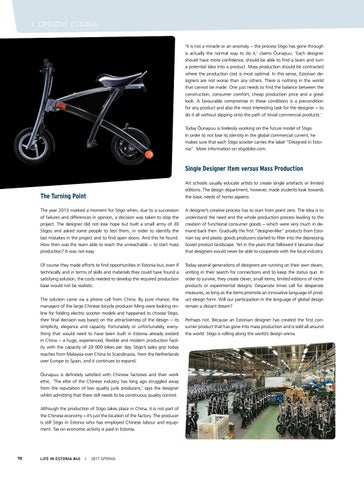I CREATIVE ESTONIA ‘It is not a miracle or an anomaly − the process Stigo has gone through is actually the normal way to do it,’ claims Õunapuu. ‘Each designer should have more confidence, should be able to find a team and turn a potential idea into a product. Mass production should be contracted where the production cost is most optimal. In this sense, Estonian designers are not worse than any others. There is nothing in the world that cannot be made. One just needs to find the balance between the construction, consumer comfort, cheap production price and a great look. A favourable compromise in these conditions is a precondition for any product and also the most interesting task for the designer − to do it all without slipping onto the path of trivial commercial products.’ Today Õunapuu is tirelessly working on the future model of Stigo. In order to not lose its identity in the global commercial current, he makes sure that each Stigo scooter carries the label “Designed in Estonia”. More information on stigobike.com.
Single Designer Item versus Mass Production
The Turning Point
Art schools usually educate artists to create single artefacts or limited editions. The design department, however, made students look towards the basic needs of homo sapiens.
The year 2013 marked a moment for Stigo when, due to a succession of failures and differences in opinion, a decision was taken to stop the project. The designer did not lose hope but built a small army of 30 Stigos and asked some people to test them, in order to identify the last mistakes in the project and to find open doors. And this he found. How then was the team able to reach the unreachable − to start mass production? It was not easy.
A designer’s creative process has to start from point zero. The idea is to understand the need and the whole production process leading to the creation of functional consumer goods − which were very much in demand back then. Gradually the first “designer-like” products from Estonian toy and plastic goods producers started to filter into the depressing Soviet product landscape. Yet in the years that followed it became clear that designers would never be able to cooperate with the local industry.
Of course they made efforts to find opportunities in Estonia but, even if technically and in terms of skills and materials they could have found a satisfying solution, the costs needed to develop the required production base would not be realistic.
Today several generations of designers are running on their own steam, uniting in their search for connections and to keep the status quo. In order to survive, they create clever, small items, limited editions of niche products or experimental designs. Desperate times call for desperate measures, as long as the items promote an innovative language of product design form. Will our participation in the language of global design remain a distant dream?
The solution came via a phone call from China. By pure chance, the managers of the large Chinese bicycle producer Ming were looking online for folding electric scooter models and happened to choose Stigo, their final decision was based on the attractiveness of the design − its simplicity, elegance and capacity. Fortunately or unfortunately, everything that would need to have been built in Estonia already existed in China − a huge, experienced, flexible and modern production facility with the capacity of 20 000 bikes per day. Stigo’s sales grip today reaches from Malaysia over China to Scandinavia, from the Netherlands over Europe to Spain, and it continues to expand. Õunapuu is definitely satisfied with Chinese factories and their work ethic. ‘The elite of the Chinese industry has long ago struggled away from the reputation of low quality junk producers,’ says the designer whilst admitting that there still needs to be continuous quality control. Although the production of Stigo takes place in China, it is not part of the Chinese economy – it’s just the location of the factory. The producer is still Stigo in Estonia who has employed Chinese labour and equipment. Tax on economic activity is paid in Estonia.
70
LIFE IN ESTONIA #45
I
2017 SPRING
Perhaps not. Because an Estonian designer has created the first consumer product that has gone into mass production and is sold all around the world. Stigo is rolling along the world’s design arena.
